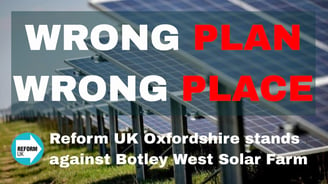Protecting Woodstock: Why Botley West Solar Power Station Demands Our Immediate Attention
Botley West Solar Farm, planned for valuable Greenbelt, is an environmental contradiction. It threatens our farmland, property values, wildlife, and Blenheim Palace's setting. I argue this project showcases the flawed economics and damaging opportunity costs of current Net Zero policies, which divert funds from essential services like the NHS. Stopping Botley West will be my absolute top priority if elected.
James Nash
4/17/20258 min read


The Botley West Project: An Environmental Paradox
The proposed Botley West development represents a contradiction at the heart of current environmental policy. According to detailed analysis, this would be one of the largest solar power stations in the world. While 18 of the top 20 largest solar schemes globally are sensibly located in desert or arid lands with high solar insolation, sparse populations, and minimal impact on food production, Botley West would occupy valuable Oxfordshire countryside.
The scale is staggering:
1,376 hectares (3,400 acres or 5 square miles)
76% on protected Greenbelt land
2.7 million solar panels
111km of security fencing
306 security cameras
A massive substation covering the equivalent of five football pitches, with structures reaching 15 meters (50 feet) in height
Most concerning is that while the solar installation has a projected 40-year lifespan, the substation infrastructure is likely to become a permanent feature in our landscape. Recent developments in the project timeline show that Merton College has withdrawn from the scheme, requiring redrawing of plans, while the Planning Inspectorate has requested adjustments to the Environmental Impact Assessment and changes to the approach to public consultation.
Growing Opposition to Botley West
West Oxfordshire District Council recently discussed their submission regarding the Botley West Solar Farm proposal, expressing deep concerns about its impact on locals and the environment. Their position reflects growing skepticism among local authorities about the appropriateness of such a massive installation in our region.
The project has also faced criticism from various quarters for being out of step with sustainable development principles. As noted by the Planning Office of The Land Is Ours (TLIO), sustainable development should encourage low-impact and affordable solutions, not industrial-scale projects that dominate the landscape.
The Immediate Impact on Our Community
This industrial-scale development would directly affect approximately 11,000 households within just 1.5km of its boundaries. The project threatens:
Agricultural Production: The land currently produces an estimated 7,000 tonnes of arable crops on good to moderate quality agricultural land. At a time when food security is increasingly important, sacrificing productive farmland represents a serious strategic misjudgment.
Local House Values: Studies consistently show negative impacts on property values near large solar installations, with effects proportional to distance and size. Evidence from various communities affected by large-scale solar developments indicates that properties can see significant devaluation, representing an uncompensated financial burden on local homeowners.
Flooding Risks: Areas like Cassington, Worton, and Yarnton already experience surface-water flooding. Scientific research confirms that solar arrays significantly alter hydrology, often increasing surface water runoff and changing soil moisture patterns. The concentration of rainfall between panel rows can lead to soil erosion and changes in drainage patterns that exacerbate existing flood risks.
Environmental "Heat Islands": Research published in Scientific Reports shows temperature increases of 3-4°C over solar installations compared to surrounding lands. This occurs primarily at night as panels release stored heat, creating microclimatic changes that can affect local weather patterns and comfort for nearby residents.
Wildlife Disruption: Studies from the University of Bristol have documented substantial reductions in bat activity near solar installations - up to 40% at edges and 86% in central areas for common pipistrelles, with similar effects on other species. The industrialization of the countryside creates barriers to wildlife movement, disrupting established migration routes and ecological corridors.
Electromagnetic Field Concerns: Underground high-voltage cables produce magnetic fields that have been associated with reduced birth weights in epidemiological studies. Even low-level electromagnetic fields can disrupt wildlife behavior, affecting everything from bee navigation to bird migration.
Cultural Heritage: The development threatens the setting of Blenheim Palace, a UNESCO World Heritage Site that represents a key part of our national heritage and local identity. The visual intrusion of industrial-scale energy production fundamentally alters the character of the landscape that has evolved over centuries.
The Wider Economic Folly of Current Net Zero Policies
The Botley West project exemplifies a broader problem with current Net Zero policies that demands urgent reconsideration. While transitioning to renewable energy is necessary, the current approach is economically unsustainable and ultimately counterproductive.
The UK's Net Zero strategy has been estimated to cost over £1 trillion by 2050, according to the Office for Budget Responsibility. This represents approximately £50,000 per household - a staggering sum that is rarely discussed honestly with the public. These costs are being incurred at a time when the UK's economic growth is already struggling, with the average household facing the most significant decline in living standards since records began.
The rush to meet arbitrary carbon reduction targets has led to:
Massive Subsidies: Renewable energy projects receive significant subsidies, adding to energy bills for ordinary citizens and businesses. The environmental and social levies on electricity bills have risen dramatically, from £7 billion in 2011 to over £12 billion in recent years. These costs are disproportionately borne by those least able to afford them, exacerbating fuel poverty which now affects over 3.16 million households in England alone.
Grid Instability: The intermittent nature of solar and wind power requires expensive backup systems or energy storage, costs which are rarely factored into the supposed economic benefits of these projects. The UK's grid infrastructure requires an estimated £30-50 billion in upgrades to accommodate renewable generation - costs that will ultimately be passed to consumers.
Manufacturing Concerns: As noted in the presentation, up to 97% of solar panels contain materials made using forced labor from the Uyghur population in China's Xinjiang region, raising serious ethical questions about supply chains. Additionally, China controls approximately 80% of the global production of solar panels, creating strategic vulnerabilities in our energy infrastructure.
Toxic Waste: Despite being marketed as "clean," solar panels contain numerous hazardous materials including cadmium compounds, selenium, indium, arsenic compounds, and various solvents that present disposal challenges at the end of their relatively short 20-25 year lifespan. The EU classifies solar panels as e-waste, yet the UK has limited facilities for recycling them properly.
Industrial Competitiveness: High energy costs driven by green levies and subsidies are forcing energy-intensive industries to relocate abroad, often to countries with less stringent environmental regulations - resulting in "carbon leakage" that may actually increase global emissions while costing British jobs. UK industrial electricity prices are approximately 60% higher than the EU average, significantly hampering our manufacturing competitiveness.
The Opportunity Cost: What We're Sacrificing
Perhaps the greatest tragedy of projects like Botley West is the opportunity cost. The billions being diverted into poorly conceived green initiatives could address genuine community needs:
Healthcare: Our local health services are under unprecedented strain, with NHS waiting lists in England reaching a record 7.75 million patients. In Oxfordshire specifically, hospital waiting times exceed national averages in several specialties.
Infrastructure: Our roads are deteriorating, with the Annual Local Authority Road Maintenance Survey estimating a £14 billion backlog in road repairs nationally. Oxfordshire's share of this backlog represents millions in needed investment that is being diverted elsewhere.
Social Care: Adult social care faces a funding crisis, with the Health Foundation estimating a £7.7 billion funding gap nationally. In Oxfordshire, this translates to vulnerable residents unable to access the support they need.
Education: Schools in Oxfordshire face significant resource constraints, with per-pupil funding failing to keep pace with inflation, resulting in larger class sizes and reduced support for students with special educational needs.
The recent £8 million expenditure to change speed limit signs from 30 MPH to 20 MPH across Oxfordshire perfectly illustrates this misallocation of resources. This costly exercise, justified on environmental and safety grounds, diverts funds from essential services while creating additional pollution as vehicles operate less efficiently at lower speeds. Similar ideologically-driven schemes like Low Traffic Neighbourhoods have been implemented at great expense despite evidence of limited benefits and significant local opposition.
The Reality of Renewable Energy Needs
Oxfordshire already generates 3% of the UK's solar energy - double our proportional share of emissions and three times the national average. According to CPRE Oxfordshire, we already have 800MW of solar capacity installed, planned, or approved.
A University of Oxford study has estimated that offshore wind alone could provide 2,120 TWh per year - more than enough to meet our renewable energy needs without sacrificing precious agricultural land and greenbelt. To achieve the UK's needs, an average of 4.15 GW in solar capacity must be installed per year, but this doesn't necessitate massive land-based installations like Botley West.
With improvements in solar panel efficiency (which has increased from about 15% to over 20% in recent years), we could generate significant renewable energy using existing structures and brownfield sites. The potential for rooftop solar in the UK is estimated at 6-8 GW, representing a substantial portion of our needs without industrializing our countryside.
A Better Way Forward
I believe in sustainable development that balances environmental, economic, and social needs. The current approach to Net Zero, exemplified by projects like Botley West, fails this test. It sacrifices productive land, community well-being, and economic common sense on the altar of arbitrary targets.
Reform UK offers a different vision - one that respects local communities, promotes genuine sustainability, and ensures that environmental policies serve the people rather than burdening them with unnecessary costs and disruption.
A more balanced approach would include:
Prioritising offshore wind and existing infrastructure: The UK has the largest offshore wind capacity in Europe and should continue to lead in this area, while maximizing generation from existing hydroelectric and nuclear plants.
Incentivising rooftop solar on commercial buildings: Large warehouse and factory roofs represent perfect locations for solar installation without sacrificing agricultural land.
Investing in nuclear power: Next-generation nuclear plants offer reliable, low-carbon energy without the intermittency problems of renewables.
Realistic transition timelines: Acknowledging that fossil fuels will remain part of the energy mix during a measured transition that doesn't compromise energy security or economic competitiveness.
Local democratic control: Ensuring communities have genuine input into major development decisions that affect their environment and quality of life.
My Commitment to You
If elected, my FIRST PRIORITY as your councillor will be to stop, review, and delay all matters related to Botley West.
This is not just my personal stance. Reform UK councillor candidates across the region stand united in making this issue our top priority. We're committed to protecting the character, environment, and economic well-being of our communities while promoting energy solutions that work for everyone.
The upcoming election is your opportunity to send a clear message that projects like Botley West must be subjected to proper scrutiny and community consent. Together, we can protect our beautiful Oxfordshire landscape while pursuing truly sustainable solutions that work for everyone.
Yours sincerely,
James Nash Reform UK Party Candidate for Woodstock - You can learn more about me here and get in touch with any questions by sending an email here:
Sources
Barron-Gafford, G.A., et al. (2016). The Photovoltaic Heat Island Effect: Larger solar power plants increase local temperatures. Scientific Reports, 6, 35070. https://doi.org/10.1038/srep35070
Blake Levitt, B., Lai, H.C., & Manville, A.M. (2022). Effects of non-ionizing electromagnetic fields on flora and fauna, part 1. Rising ambient EMF levels in the environment. Reviews in Environmental Health, 37(3), 327-406.
Bunch, K.J., et al. (2015). Residence close to high-voltage power lines and risk of cancer in the UK: a case-control study. Journal of Radiological Protection, 35(3), 695-705.
Committee on Climate Change. (2020). The Sixth Carbon Budget: The UK's path to Net Zero. https://www.theccc.org.uk/publication/sixth-carbon-budget/
CPRE Oxfordshire. (2023). Solar Energy in Oxfordshire. https://www.cpreoxon.org.uk/
De Vocht, F., & Lee, B. (2014). Residential proximity to electromagnetic field sources and birth weight: Minimizing residual confounding using multiple imputation and propensity score matching. Environment International, 69, 51-57.
Health Foundation. (2023). Adult social care funding gap. https://www.health.org.uk/publications/reports/adult-social-care-funding-gap
Mulvaney, D. (2019). Solar Power: Innovation, Sustainability and Environmental Justice. University of California Press, 329pp.
NHS England. (2023). Waiting times for hospital treatment. https://www.england.nhs.uk/statistics/statistical-work-areas/rtt-waiting-times/
Office for Budget Responsibility. (2021). Fiscal Risks Report. https://obr.uk/frr/fiscal-risks-report-july-2021/
Oxfordshire County Council. (2023). 20mph speed limits. https://www.oxfordshire.gov.uk/residents/roads-and-transport/traffic/20mph-speed-limits
Private Eye. (2023). Issue 1609. Article on Blenheim Estate and Dominic Hare.
Smith School of Enterprise and the Environment, University of Oxford. (2023). UK Energy Potential. https://www.smithschool.ox.ac.uk/
Stop Botley West Campaign. (2023). Information on the proposed solar farm. https://stopbotleywest.com/home
West Oxfordshire District Council. (2023). Council discussions on Botley West Solar Farm. https://www.westoxon.gov.uk/
Yarnton Parish Council. (2022). Information on surface water flooding in the parish. https://www.yarnton-pc.gov.uk/
Yavari, F., et al. (2022). Environmental impacts of utility-scale solar farms: a comprehensive review. Environmental Research: Infrastructure and Sustainability, 2, 032002.


Dear Residents of Woodstock and Surrounding Communities,
As your Reform UK candidate for the upcoming local elections, I want to address what I believe is the most pressing concern facing our beautiful region: the proposed Botley West Solar Utility Scale Power Station. This project exemplifies a wider national problem where ideologically-driven policies are being pursued without proper consideration of their real-world impacts on communities, the environment, and our economy.
Reform UK Bicester & Woodstock
Common sense solutions for British political issues.
Engage
Connect
chair.baw@reformuk.com
© 2024. All rights reserved.
Promoted by Reform UK Party Limited - Copyright © 2024 Reform UK Party Limited
Company number 11694875 | Registered in England & Wales
